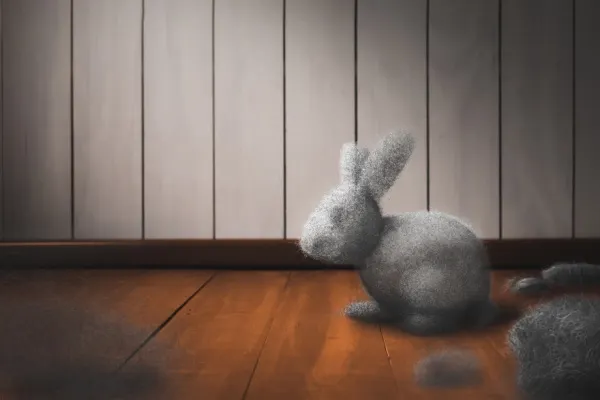
Everything You Need to Know About Dust Bunnies
The term “dust bunny” calls to mind a cute and harmless little creature. Don’t be fooled. They are, in fact, quite the nuisance, and can even harm your health.
With that in mind, let’s take a look at exactly what they are, where they’re typically found, and how you can rid your home of them.
First, What Are Dust Bunnies?
Simply put: Dust bunnies are fluffy clumps of dust particles. According to a 2009 University of Arizona study, the dust found in homes contains “a mixture of organic matter such as shed skin cells and organic fibers, soil tracked-in on footwear, and particulate matter derived from the infiltration of outdoor air.”
How Do Dust Bunnies Form?
Dust bunnies form when particles of dust and other debris move around your home. Static electricity and tangled-up hair create the perfect catalysts for buildup of this material, eventually creating the visible ball of fuzz that we call a dust bunny.
As they form, the dust bunnies collect additional debris and dust mites. A gram of dust can contain thousands of dust mites, their waste causing sneezing and more serious health problems in those who are allergic. Just imagine the misery they unleash as part of a bunny-sized clump!
Where Do Dust Bunnies Live in My Home?
Dust bunnies like to hide, coming out only after you’ve spent hours cleaning up for the guests.
Favorite hiding spots for dust bunnies include:
- Under, around and behind appliances — pull the fridge and stove out once a month to sweep the area clean.
- Under and behind furniture — move couches and tables as part of your cleaning routine to corral dust bunnies.
- Behind mattresses and box springs — the areas behind and underneath your bed collect dust, so be sure to dust them every time you change the sheets.
- On the floor, in corners — vacuum these awkward spots, as well as molding, to dislodge bunnies.
- In anything with a pleat — if your curtains, bed skirts or lampshades have pleats, expect to find a dusty mess inside them.
How To Get Rid of Dust Bunnies?
Now that you know where they live, when they aren’t embarrassing you in front of company, that is, you can tackle them before they get too big …
In addition to the directions above, follow these additional recommendations:
- Invest in a vacuum cleaner with a high-efficiency particulate air filter.
This type of filter features a fine mesh that traps dust and other harmful particles.
- Put your vacuum attachments to work, matching each to the task.
Use the crevice tool to attack baseboards, ceiling molding and the spaces in-between appliances that you don’t plan to pull out that week. Use the upholstery tool to capture dust on soft pieces of furniture, sucking up dust mites. Don’t forget the backs and sides of couches and under the cushions.
- For surfaces you shouldn’t vacuum, such as your TV, keep microfiber cloths on hand.
Microfiber cloths are a dusting powerhouse. They gently clean and trap dust instead of sending it on to settle elsewhere.
- Finally, bring in the professionals for a deep cleaning once a season.
A maid service can clean inside your house, while a handyman or HVAC technician can clean ducts and vents to ensure dust bunnies living in those spaces don’t multiply and move into interior rooms. A carpet cleaner can suck up anything embedded and even steam clean your upholstery during the visit.
One final tip: While dust bunnies don’t usually form on blinds and ceiling fans because of their constant use, that doesn’t mean their smaller particulate cousins don’t build up. Invest in dusting tools for these items to make cleaning them easy and not a dreaded chore.
Let the Professionals Clean Your Home
For your home cleaning needs, call the professionals at Molly Maid, a trusted Neighborly company. Each of our maid service teams has insured, licensed and uniformed housekeepers. Click here to request service in your area.
